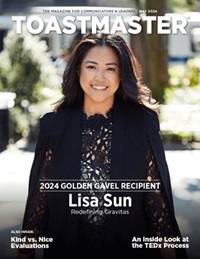
Improving public speaking skills and overcoming stage fright are probably the top two reasons people join Toastmasters. Your club can help you with both, but transferring those skills to your daily workplace—with its often more intimidating and high-stakes environment—might be tougher than anticipated.
Toastmasters clubs provide a safe, supportive environment, with a clear framework and specific tasks. Your primary goal with a club speech is to deliver something engaging, thought-provoking, moving, and entertaining, often with emotional personal touches and sometimes even small props. You receive applause even for filling a minute with erudite speech when answering a Table Topic®.
Work presentations are different. First, there is likely no applause, and often the goal is to simply get a list of points across. When someone asks you a question, they expect a clear and concise answer, not an entertaining response between one and two minutes.
That doesn’t mean your Toastmasters skills don’t translate to everyday questions or work presentations. You just need to use the skills differently and adapt to a different type of audience. Here are some helpful tricks to ease the transition.
Don’t Jump Into the Presentation
Work presentations are mainly informational, and in fact, may need to contain so much information that they become unwieldly. On top of that, you may not feel you have time for the storytelling and motivational techniques, or the subject doesn’t lend itself to incorporating them. However, you still want to start by finding a way to engage your audience and draw them in.
A good way to do that is to pare down the nonessential elements, even to just a sentence, while still leaning into the speechwriting structure you’ve learned. You can begin with a strong opening statement, such as mentioning the larger goal you are working toward, a new finding, or the concept you’d like to discuss. Then add a hook, such as a rhetorical question or interesting finding; sprinkle in a short personal anecdote; and begin your presentation.
It may look like this: You briefly mention what the meeting is about and why it is important (opening), sprinkle in an intriguing fact to get their attention (hook), and then explain how you or your team is passionately involved in it (the personal story). After that, you present the actual points, organized in a clear manner with transitions between each one.
The opening and the hook are two important speech components that often get overlooked in work presentations. However, even though attendees likely know why they are in the meeting, it helps to refresh their memory and ensure you’re all focused on the same issue. By adding a hook and a personal anecdote, you capture their attention and get them engaged right away.
If you are completely out of inspiration or your presentation topic is not that suitable for personal stories, you should still take the time to mention why the meeting is important and entice the audience with what they are going to learn or discover, instead of dropping in agenda items.
Acknowledge Any Preconceptions
Don’t feel that a dry topic is an obstacle—Toastmasters has given you the skills for that situation as well. If you need to present something that you know your audience will deem a bit dull, pull out some Toastmasters tools to make it more engaging. For instance, if you anticipate the audience may find your points a bit abstract, address that head-on at the beginning with humor. Mention that you aren’t Einstein either, but compared to working through string theory, this meeting is going to be a breeze! Or, provide a brief intro describing how each point relates to the other ones, to draw your audience in and make them feel acknowledged.
Similarly, if you anticipate there are so many points to get through it could lead to attention fatigue, address that directly and assure your audience with a smile you would also like to end the meeting on time. This helps acknowledge their concerns, while recognizing that everyone wants to get the most out of the meeting yet also has other commitments.
Remember Your Pauses and Gazes
One very effective skill you learn in Toastmasters is the pause. Pauses are rarely actively practiced in workplace situations; however, they are remarkably effective at bringing attention to the points you want to make. Often a pause brings more emphasis than any powerful phrase or tone you use. And they are certainly better than raising your voice. Pauses can give you an air of authority and make your audience lean in and listen to what you have to say, regardless of your seniority level or relative importance of your project.
Another highly effective yet underutilized skill is focusing your gaze. When looking into the room, use the Toastmasters skill of pairing “gaze with a phrase.” Rather than talking to the middle wall or only looking at your manager, try addressing one side of the room for one point, and another part for a different point. This technique helps everyone in the room feel addressed and included.
You can also play with your vocal variety. When you have an important point to make or want to bring attention to a crucial detail, either increase the enthusiasm in your voice or lower it slightly and slow down. Of course, you don’t want to sound too theatrical, but a bit of tonal variation helps break up a monotonous presentation.
Don’t Neglect Body Language
After your speechwriting skills, effective body language is the next most powerful tool to make your presentation more professional. Even knowing such basic guidelines as not standing with crossed arms helps convey the right image. Use deliberate hand motions, like you would in a club speech, and rather than pacing, walk across the stage or floor with purpose.
If you need to present something that you know your audience will deem a bit dull, pull out some Toastmasters tools to make it more engaging.
Practice your presentation ahead of time so you don’t end up reading word for word from the lectern. Instead, try to internalize your speech or write down the main points and refer to them if that feels more comfortable. An audience feels more at ease when you feel at ease, and not stressing about the exact wording helps in that endeavor. If there is a particular quote or phrase you need to get right word-for-word, feel free to read just that part out loud from the paper—in fact, doing this can help grab an audience’s attention as the break in presentation style signals something important.
Lean on Table Topics Techniques
If there are any questions at the end of your presentation, use some Table Topics strategies. For instance, the simple Toastmasters trick of repeating the question in your initial response not only buys you time, it also confirms you understood the question. You can do the same at work, perhaps adding something along the lines of “that is a good question, and it indeed relates to …,” which also address the quality of the question and buys you more time to actually answer. Where appropriate, you can add an example relating to your answer just like you would do in your Toastmasters response, but, of course, avoid being unnecessarily wordy.
Toastmasters is a fantastic environment to grow your confidence, techniques, and experience, all of which are directly applicable to workplace presentations and situations. Your Toastmasters skills of speechwriting, body language, effective pauses and gazes, and touches of humor help engage your audience and make it easier to understand and absorb your points.
So let your Toastmasters skills flourish not only inside, but also outside of Toastmasters. And the next time someone praises your presentation prowess, let them know about your secret weapon of Toastmasters membership.
Victor David is Immediate Past President of the City Tattersalls Toastmasters Club in Sydney, Australia, where he works for the government as a senior communications advisor. He is founder of aixplainer.com, a platform that helps people to understand AI better. Contact him at victor@aixplainer.com.
Related Articles

Professional Development
Tips for Powerful Workplace Presentations

Professional Development


 Previous
Previous

 Previous Article
Previous Article

